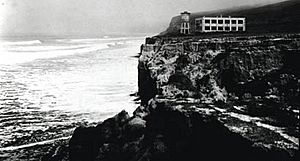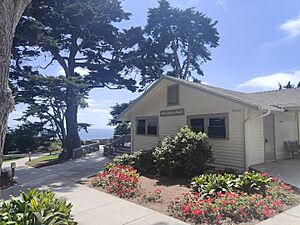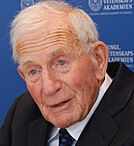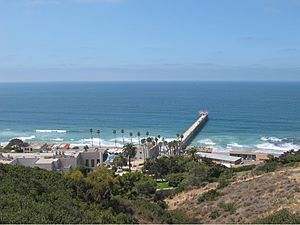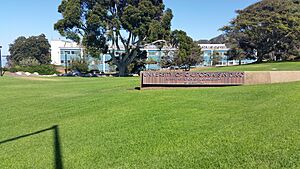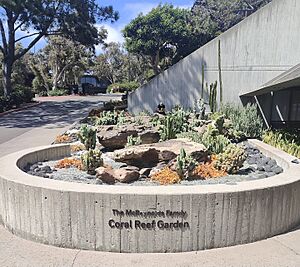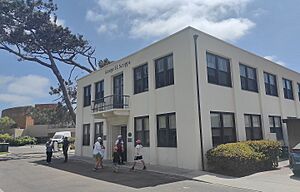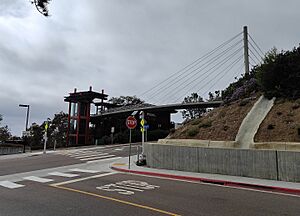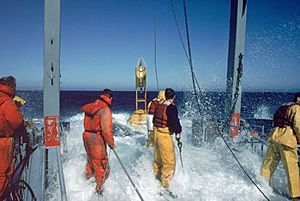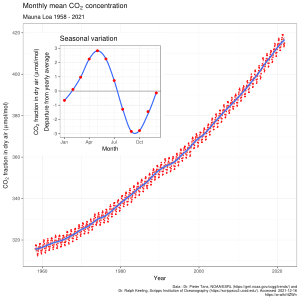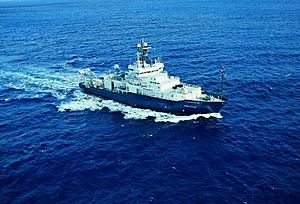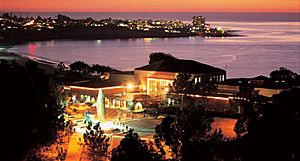Scripps Institution of Oceanography facts for kids
 |
|
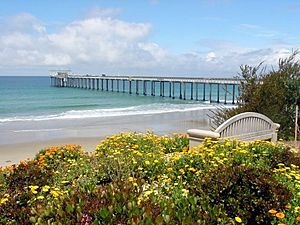
Ellen Browning Scripps Memorial Pier
|
|
|
Former name
|
Marine Biological Association of San Diego Scripps Institution for Biological Research |
|---|---|
| Established | 1903 |
| Research type | Public |
|
Field of research
|
Oceanography |
| Director | Margaret Leinen |
| Faculty | 415 |
| Staff | 800 |
| Students | 350 Postgraduates |
| Location | San Diego, California, United States of America 32°51′56″N 117°15′13″W / 32.865437°N 117.253626°W |
| Affiliations | University of California, San Diego |
The Scripps Institution of Oceanography (SIO) is a famous place for studying the ocean and Earth. It is part of the University of California, San Diego. Its main campus is in La Jolla, California. SIO also has other buildings in Point Loma.
This institution started in 1903. It joined the University of California system in 1912. Since then, SIO has grown to study many things. These include the physics, chemistry, geology, biology, and climate of our planet. Each year, SIO gives out the Nierenberg Prize. This award honors scientists who make great contributions to science for the public good.
Contents
Exploring Ocean History
How Scripps Began
The Scripps Institution of Oceanography started with William Emerson Ritter. He was a biologist from Wisconsin. In 1891, Ritter became a biology teacher at the University of California, Berkeley. He and his wife, Mary Bennett, visited San Diego. There, Ritter met Fred Baker, a local doctor. Baker encouraged Ritter to build a marine biology lab in San Diego.
Ritter looked for a good place for a lab for eleven years. He spent summers studying the coast with his students. Money and a suitable location were hard to find. During this time, some research happened at the Hotel del Coronado boathouse.
In 1903, Ritter met E. W. Scripps, a newspaper owner. With Scripps' half-sister, Ellen Browning Scripps, and Fred Baker, they created the Marine Biological Association of San Diego. Ritter was the science director. The Scripps family paid for the institution for its first ten years. E. W. Scripps even let them use his yacht, the Loma, in 1904. This was the first research boat for the institution.
In 1905, they moved to a small lab in La Jolla Cove. Later, they bought a 170-acre site in La Jolla. This land cost $1,000 from the city of San Diego. It is where the main SIO campus is today. Building a permanent lab cost about $50,000. The Scripps family provided the money. The first permanent building, now called the Old Scripps Building, was finished in 1910.
The Loma ran aground in 1906. This meant they needed a new research boat. Ellen Browning Scripps provided funds for a new ship. This vessel was built just for ocean research. It was one of the first for a non-government group in America. The new boat, named Alexander Agassiz, arrived on April 21, 1907. It was 85 feet long and had sails and two gasoline engines. It served the institution for ten years.
In 1912, the Biological Association joined the University of California. Its name changed to the Scripps Institution for Biological Research.
The first Scripps Pier was approved in 1913. It was finished in 1916 due to delays from World War I. In 1915, the first building just for an aquarium was built. It had 19 tanks of different sizes. A museum was in a nearby building. Since the pier was built, measurements have been taken daily. The modern Scripps Pier replaced the 1916 one in 1988.
The institution's name changed again in October 1925. It became the Scripps Institution of Oceanography (SIO). This new name showed that the scientists were studying more than just biology.
In 1934, Easter Ellen Cupp became the first woman to get a Ph.D. in oceanography from SIO. She studied tiny ocean plants called diatoms.
In 1935, SIO director T. Wayland Vaughan won the Alexander Agassiz Medal. This award is from the National Academy of Sciences. Other Scripps scientists, like Harald Sverdrup and Roger Revelle, also won this medal later.
In 1936, the research vessel Scripps sank after an explosion. The cook died, and the captain was hurt. SIO needed a new boat. They bought a yacht from actor Lewis Stone in 1937. It was renamed E. W. Scripps. This ship was very important for studying ocean currents.
Scripps During Wartime
During World War II, Scripps helped the US Navy. They created the University of California Division of War Research (UCDWR). This group studied ocean sounds and waves. Their work helped discover the deep scattering layer. This is a deep part of the ocean full of living things. UCDWR also researched sonar technology.
Harald Sverdrup, the SIO director, and student Walter Munk helped the Allies. They predicted ocean conditions for soldiers landing on beaches in Africa and Europe. Their models helped with landings in Normandy and Sicily. SIO trained over 200 military officers in forecasting ocean swells.
The war changed how Scripps got money. Before the war, the Navy only supported SIO to protect ship hulls. During the war, research on physical oceanography became important for submarine warfare. Roger Revelle became a Navy contact for oceanography. Research led to better bathythermographs. These tools measure ocean temperature at different depths. Scientists also learned more about the thermocline and ocean floor sediments.
In 1942, Sverdrup, Martin Johnson, and Richard Fleming wrote The Oceans. This was the first full textbook on oceanography. It was so important for the military that it was kept secret.
The first scientific diver at SIO was Cheng Kwai Tseng in 1944. He collected algae to help the US make its own agar. Agar was important for hospitals.
The Golden Age of Oceanography
After the war, Roger Revelle helped oceanographers get more support. He worked with the Office of Naval Research (ONR). This led to Scripps getting about $900,000 each year from the government.
The Navy gave several ships to SIO. This started a "Golden Age" of ocean research. Between 1947 and 1949, three new vessels were used for science. These ships helped with the Marine Life Research Program in 1950. This program studied why the California sardine population was shrinking.
In 1950, the Aqua-Lung became available. UCLA graduates Conrad Limbaugh and Andy Rechnitzer brought it to SIO. They started the Scripps Diving Program. After a diving accident, Roger Revelle asked Limbaugh to create a scuba training program. This program started in 1951. Hugh Bradner, a physicist, developed the wetsuit in 1952. The SIO Diving Program grew to have over 160 divers by 2015.
The Vaughan Aquarium-Museum opened in 1951. It replaced an older aquarium. This new museum was named after former director T. Wayland Vaughan. It was much bigger and also had offices and preserved specimens.
In 1959, a new administration building was built. It was called the "New Scripps" building. More buildings, like the Sumner Auditorium and Sverdrup Hall, were added in 1960.
Roger Revelle helped create the University of California, San Diego in 1960. SIO was the main part of this new university. In the 1960s, SIO developed the Deep-Tow system. This system helped map the ocean floor. It was used in Project FAMOUS to study underwater mountains.
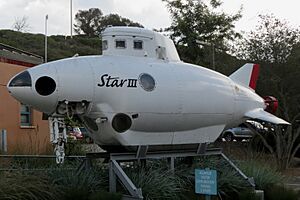
In 1965, Scripps started using land in Point Loma for its research vessels. This included the RP Flip, a unique research platform. The Navy gave this land to Scripps in 1975. It was named the Nimitz Marine Facility (MarFac).
Also in 1965, Scripps helped the Navy with the SEALAB project. Divers lived in an underwater habitat for 15 days. This happened 205 feet deep in the nearby Scripps Canyon.
In 1968, Scripps researcher Harmon Craig helped start GEOSECS. This was a big international project to study ocean chemistry. It helped create many future ocean research programs.
In 1973, California Sea Grant became a college program. It is managed by Scripps Institution of Oceanography.
From 1979, SIO led the RISE project. This project discovered black smoker hydrothermal vents at the East Pacific Rise. These vents are like underwater geysers.
Modern Ocean Research
The Old Scripps Building, designed by Irving Gill, became a National Historic Landmark in 1982. This means it is a very important historical place.
In 1998, Scripps leaders helped create the Partnership for Observation of the Global Ocean (POGO). This is an international group of oceanographic institutions. They work together to observe the global ocean.
In 2014, SIO tested using biofuels on one of its ships, the Robert Gordon Sproul. The ship ran on 100% biofuels for over a year. This showed that research ships could use cleaner fuel.
Also in 2014, the international GO-SHIP program began. Scripps helps lead this program. It studies ocean temperature, saltiness, and currents across major ocean basins.
In 2019, Scripps received money for a new 42-foot research vessel. It was named after John Beyster and his wife Betty.
From 2019, SIO studied water pollution at Imperial Beach. They found high levels of harmful bacteria. In 2024, Scripps joined a task force to understand the health effects of this pollution.
A report in 2022 showed that women make up 26% of research scientists at SIO. However, they use only 17% of the lab and office space. The report also noted that older, retired male faculty members hold a large amount of space.
Scripps Campus
Main Campus Area
The main SIO campus is in La Jolla. It is located between La Jolla Shores and Black's Beach. La Jolla Shores Drive leads to La Jolla and the main UC San Diego campus.
Buses serve the campus regularly. The MTS line 30 and UC San Diego's SIO bus route stop here. These buses connect the campus to other parts of San Diego.
Three places on campus can be rented by the public. These are the Seaside Forum, the Martin Johnson House, and Birch Aquarium.
Biological Grade
Biological Grade is a street on campus. It runs north to south. Many labs, libraries, and research halls are along this street. It was built between 1910 and 1912. It was once part of the main road between San Diego and Los Angeles. Later, La Jolla Shores Drive was built for through traffic. Biological Grade connects to Shellback Way by a pedestrian bridge. This bridge is called Scripps Crossing.
The Scripps Coastal Meander trail starts at the north end of Biological Grade. It connects to other trails and ends at Black's Beach.
Pawka Green and Naga Way
South of Biological Grade is Pawka Green. It is named after Steven Pawka. Naga Way separates the labs from the buildings around Pawka Green. These buildings are mostly for administration and teaching. Naga Way is named after the Naga Expedition. This expedition studied the Gulf of Thailand in 1959.
Shellback Way
Shellback Way connects labs and halls on the east side of La Jolla Shores Drive. These buildings focus on atmospheric science and fisheries. It connects to Biological Grade by the Scripps Crossing bridge. Shellback Way is named after the Shellback Expedition. This expedition studied the deep Pacific Ocean in 1952.
Downwind Way
Downwind Way connects La Jolla Shores Drive to Expedition Way. This part of campus has storage, facilities, Birch Aquarium, and the Deep Sea Drilling Program. It is named after one of the International Geophysical Year cruises from 1957-1958.
Campus Plants and Animals
The main campus is next to the San Diego-Scripps Coastal Marine Conservation Area. It is also near Torrey Pines State Natural Reserve. The coastal chaparral area has many plants. These include lemonade berry, wild cucumber, and California sunflower.
Many seabirds are seen near campus. These include seagulls, pelicans, and osprey. Peregrine falcons sometimes nest in the cliffs at the north end of campus.
Marine Life
You can see marine life in the shallow waters from La Jolla Shores to Black's Beach. This makes snorkeling popular. Some animals include leopard sharks, Garibaldi, and round stingrays. Because there are many stingrays, locals do the "stingray shuffle." This helps them avoid being stung.
Scripps Canyon is a popular place for divers and marine research. It connects to La Jolla Canyon. Fish found here include poachers, sole, and rockfish.
Nimitz Marine Facility
The Nimitz Marine Facility is where all SIO research vessels are kept. It is in Point Loma. This facility is next to the Point Loma Navy Base. To enter the waterfront area, you need a special ID card.
Ocean Research Programs
Scripps studies many things about the oceans and land. This includes biology, physics, chemistry, geology, and how oceans interact with climate. Scripps also offers college degrees in these subjects.
Today, Scripps has about 1,300 staff members. This includes 235 faculty and 350 graduate students. Its yearly budget is over $281 million. SIO operates a fleet of four oceanographic research vessels.
Research Focus Areas
Scripps focuses on several important research areas:
- Climate change and how we adapt to it
- Being ready for natural hazards
- How oceans affect human health
- Developing new technology
- Studying the polar regions
- Protecting biodiversity
- National security
CalCOFI Program
The California Cooperative Oceanic Fisheries Investigations (CalCOFI) program started in 1949. It is a partnership between SIO, NOAA Fisheries, and the California Department of Fish and Wildlife. They study sardine populations and the ocean environment off Southern California. They collect data on regular research trips. This data helps them compare changes over many decades.
The Keeling Curve
The Keeling Curve is a very important record. It shows the amount of carbon dioxide (CO2) in the air. This record started in 1958. Charles David Keeling led this project. SIO set up a research center in Mauna Loa, Hawaii to measure CO2 levels. Now, SIO scientists collect data from many places. They use this data to monitor climate change.
Argo Program
The Argo program is an international project. It measures ocean temperature, saltiness, and currents. It started in the late 1990s. SIO scientists helped design the special floats used in this program. SIO also hosts Argo data online.
Ocean Collections
SIO has a huge collection of marine and deep-sea organisms. These samples date back to 1902. When fish scientist Carl Hubbs arrived in 1944, the collections grew quickly. SIO also has a geological collection. It includes thousands of ocean cores, rock samples, and tiny microfossil slides.
These collections are used for teaching at SIO. They are also used for public education at Birch Aquarium.
How Scripps is Organized
Research Divisions
Scripps Oceanography has three main research divisions:
- Biology
- Center for Marine Biotechnology & Biomedicine (CMBB)
- Integrative Oceanography Division (IOD)
- Marine Biology Research Division (MBRD)
- Earth
- Cecil H. and Ida M. Green Institute of Geophysics and Planetary Physics (IGPP)
- Geosciences Research Division (GRD)
- Oceans & Atmosphere
- Climate, Atmospheric Science & Physical Oceanography (CASPO)
- Marine Physical Laboratory (MPL)
Scripps Directors
Margaret Leinen became the director of Scripps Institution of Oceanography on October 1, 2013. She is also a Vice Chancellor for Marine Sciences and Dean of the Graduate School of Marine Sciences.
List of SIO Directors
| No. | Image | Director | Term start | Term end | |
|---|---|---|---|---|---|
| 1 |  |
William E. Ritter | 1912 | 1923 | |
| 2 |  |
Thomas W. Vaughan | 1923 | 1936 | |
| 3 |  |
Harald U. Sverdrup | 1936 | 1948 | |
| 4 |  |
Carl Eckart | 1948 | 1950 | |
| 5 |  |
Roger Revelle | 1951 | 1964 | |
| 6 | Fred N. Speiss | 1964 | 1965 | ||
| 7 |  |
William A. Nierenberg | 1965 | 1986 | |
| 8 |  |
Edward A. Frieman | July 1, 1986 | August 31, 1996 | |
| – |  |
Wolfgang H. Berger | September 1, 1996 | January 31, 1998 | |
| 9 |  |
Charles F. Kennel | February 1, 1998 | September 11, 2006 | |
| 10 |  |
Tony Haymet | September 12, 2006 | September 30, 2012 | |
| – |  |
Catherine Constable | October 1, 2012 | September 30, 2013 | |
| 11 |  |
Margaret Leinen | October 1, 2013 | present |
Research Vessels
Scripps owns and operates several research vessels and platforms. These are special ships used for scientific studies in the ocean.
- RV Roger Revelle
- RV Sally Ride
- RV Robert Gordon Sproul
- RV Bob and Betty Beyster
Past and Present Research Vessels (larger than 50 feet)
| Year Acquired by SIO | Retired from SIO | Name | Notes |
|---|---|---|---|
| 1904 | 1906 | RV Loma | Pilot boat, ran aground in Point Loma |
| 1907 | 1917 | RV Alexander Agassiz | Schooner |
| 1918 | 1918 | RV Ellen Browning | |
| 1925 | 1936 | RV Scripps | Converted from a fishing vessel, exploded in 1936 |
| 1937 | 1955 | RV E. W. Scripps | |
| 1955 | 1965 | RV Stranger | Operated as USS Jasper from 1941 to 1947 for the UC Division of War Research |
| 1947 | 1956 | RV Crest | |
| 1947 | 1969 | RV Horizon | |
| 1948 | 1965 | RV Paolina-T | |
| 1949 | 1968 | RV Horizon | |
| 1951 | 1965 | RV Spencer F. Baird | |
| 1955 | 1969 | T-441 | |
| 1956 | 1962 | RV Orca | |
| 1959 | 1963 | RV Hugh M. Smith | |
| 1959 | 1970 | RV Argo | Official Navy name was Snatch |
| 1962 | 1976 | RV Alexander Agassiz | |
| 1962 | 2023 | RP FLIP | Designated RP as a Research Platform |
| 1962 | 1974 | RV Oconostota | The Oconostota was known as "The Rolling O" because of its unpleasant motion |
| 1965 | 1980 | RV Alpha Helix | Transferred to University of Alaska, Fairbanks in 1980, sold in 2007 to Stabbert Maritime |
| 1965 | 1984 | RV Ellen B. Scripps | |
| 1966 | 1992 | RV Thomas Washington | Transferred to Chile and renamed Vidal Gormaz. Scrapped 2012 |
| 1969 | 2014 | RV Melville | Transferred to the Philippines in 2016 and renamed Gregorio Velasquez |
| 1973 | RV Gianna | ||
| 1978 | 2015 | RV New Horizon | |
| 1984 | Present | RV Robert Gordon Sproul | |
| 1995 | Present | RV Roger Revelle | |
| 2016 | Present | RV Sally Ride | |
| 2019 | Present | RV Bob and Betty Beyster | 42-feet long |
Future Hybrid Hydrogen Research Vessel
In 2021, Scripps received $35 million to build a new coastal research vessel. This ship will replace the RV Robert Gordon Sproul. The new vessel will be 125 feet long and take three years to build. It will be the first hybrid-hydrogen research vessel in the UNOLS fleet. This will help the University of California reach its goal of being carbon neutral. The ship is expected to run on hydrogen power for 75% of its trips.
Birch Aquarium
Birch Aquarium is the public part of Scripps. It has a Hall of Fishes with over 60 tanks. You can see Pacific fish and invertebrates from different ocean areas. There is also a 13,000-gallon exhibit for local sharks and rays. Kids can explore interactive tide pools and science exhibits. In 2022, the aquarium opened a new exhibit for blue penguins.
Famous People at Scripps
- Farooq Azam
- George Backus
- Andrew Benson
- Hugh Bradner
- Theodore Holmes Bullock
- Ralph J. Cicerone
- Harmon Craig
- Paul J. Crutzen
- Paul K. Dayton
- Robert S. Dietz
- Carl Eckart
- Edward A. Frieman
- Freeman Gilbert
- Edward D. Goldberg
- Klaus Hasselmann
- Sam Hinton
- Carl Hubbs
- Douglas Inman
- John Dove Isaacs
- Jeremy Jackson
- Martin W. Johnson
- Thomas H. Jordan
- Miriam Kastner
- Charles David Keeling
- Ralph Keeling
- Charles Kennel
- Nancy Knowlton
- Lisa Levin
- Ralph A. Lewin
- Michael S. Longuet-Higgins
- Henry William Menard
- Mario J. Molina
- John W. Miles
- Walter Munk
- Jerome Namias
- William Nierenberg
- Pearn P. Niiler
- Roger Revelle
- William Emerson Ritter
- Dean Roemmich
- Richard Heinrich Rosenblatt
- Enric Sala
- Hans Suess
- Francis Parker Shepard
- Richard Somerville
- Fred Spiess
- George Sugihara
- Harald Sverdrup
- Lynne Talley
- Victor Vacquier
- Shang-Ping Xie
Awards from SIO
SIO gives out several awards. These awards recognize scientific achievements or contributions to society.
| Award | First Given | Latest Recipient | Note |
|---|---|---|---|
| Amici cum Laude
(Latin: "friends with praise") |
1996 | 2013 | An honor for supporters or friends in the greater oceanographic community |
| Cody Award | 1989 | 2021 | Scientific achievement; Named after Robert L. and Bettie P. Cody |
| Frieman Prize | 1996 | 2022 | For graduate student research; Edward Frieman |
| Nierenberg Prize | 2001 | 2023 | For contributions to research and public interest; William Nierenberg |
| Ritter Memorial Fellowship | 1990 | 2020 | Encouraging fellowship in the history of marine science; William Ritter |
| Roger Revelle Prize | 2009 | 2009 | For leaders in public or private sectors; Roger Revelle |
| Rosenblatt Award | 2005 | 2019 | For contributions in evolutionary biology; Richard H. and Glenda G. Rosenblatt |
| Teaching Awards | 2003 | 2023 | Two awards for graduate/undergraduate teaching and mentorship |
See Also
- Array Network Facility
- RISE project
- Scripps Research, a nearby medical research institute
- Monterey Bay Aquarium Research Institute, a private ocean research center
- Moss Landing Marine Laboratories, a marine research group
- Hopkins Marine Station, a research facility by Stanford University
- Hatfield Marine Science Center, a research facility by Oregon State University
- Woods Hole Oceanographic Institution, a similar research facility in Massachusetts


